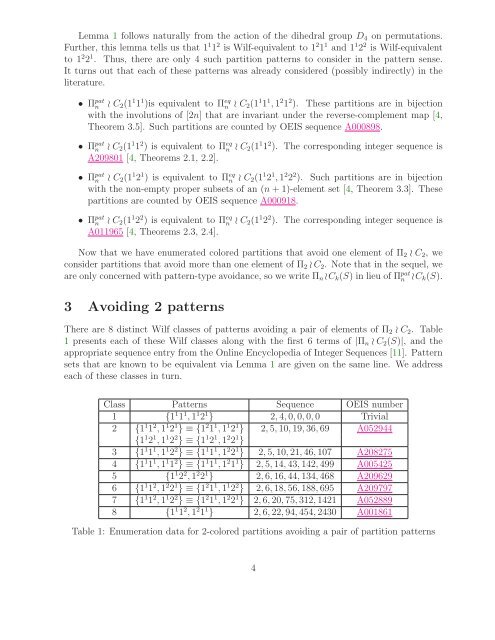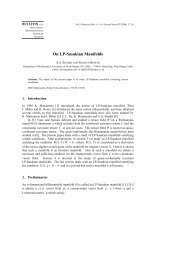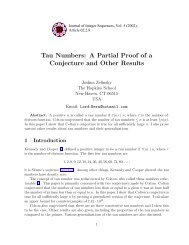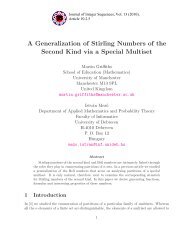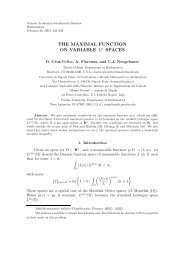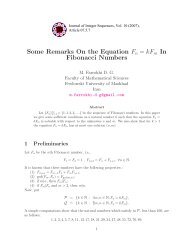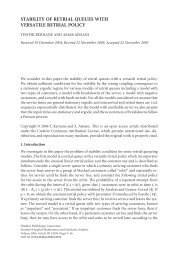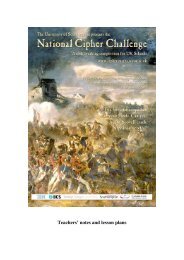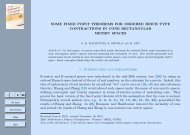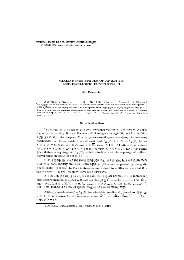Avoiding Colored Partitions of Two Elements in the Pattern Sense
Avoiding Colored Partitions of Two Elements in the Pattern Sense
Avoiding Colored Partitions of Two Elements in the Pattern Sense
Create successful ePaper yourself
Turn your PDF publications into a flip-book with our unique Google optimized e-Paper software.
Lemma 1 follows naturally from <strong>the</strong> action <strong>of</strong> <strong>the</strong> dihedral group D 4 on permutations.Fur<strong>the</strong>r, this lemma tells us that 1 1 1 2 is Wilf-equivalent to 1 2 1 1 and 1 1 2 2 is Wilf-equivalentto 1 2 2 1 . Thus, <strong>the</strong>re are only 4 such partition patterns to consider <strong>in</strong> <strong>the</strong> pattern sense.It turns out that each <strong>of</strong> <strong>the</strong>se patterns was already considered (possibly <strong>in</strong>directly) <strong>in</strong> <strong>the</strong>literature.• Π patn≀ C 2 (1 1 1 1 )is equivalent to Π eqn ≀ C 2 (1 1 1 1 , 1 2 1 2 ). These partitions are <strong>in</strong> bijectionwith <strong>the</strong> <strong>in</strong>volutions <strong>of</strong> [2n] that are <strong>in</strong>variant under <strong>the</strong> reverse-complement map [4,Theorem 3.5]. Such partitions are counted by OEIS sequence A000898.• Π patn ≀ C 2 (1 1 1 2 ) is equivalent to Π eqn ≀ C 2 (1 1 1 2 ). The correspond<strong>in</strong>g <strong>in</strong>teger sequence isA209801 [4, Theorems 2.1, 2.2].• Π patn≀ C 2 (1 1 2 1 ) is equivalent to Π eqn ≀ C 2 (1 1 2 1 , 1 2 2 2 ). Such partitions are <strong>in</strong> bijectionwith <strong>the</strong> non-empty proper subsets <strong>of</strong> an (n + 1)-element set [4, Theorem 3.3]. Thesepartitions are counted by OEIS sequence A000918.• Π patn ≀ C 2 (1 1 2 2 ) is equivalent to Π eqn ≀ C 2 (1 1 2 2 ). The correspond<strong>in</strong>g <strong>in</strong>teger sequence isA011965 [4, Theorems 2.3, 2.4].Now that we have enumerated colored partitions that avoid one element <strong>of</strong> Π 2 ≀ C 2 , weconsider partitions that avoid more than one element <strong>of</strong> Π 2 ≀ C 2 . Note that <strong>in</strong> <strong>the</strong> sequel, weare only concerned with pattern-type avoidance, so we write Π n ≀C k (S) <strong>in</strong> lieu <strong>of</strong> Π patn ≀C k (S).3 <strong>Avoid<strong>in</strong>g</strong> 2 patternsThere are 8 dist<strong>in</strong>ct Wilf classes <strong>of</strong> patterns avoid<strong>in</strong>g a pair <strong>of</strong> elements <strong>of</strong> Π 2 ≀ C 2 . Table1 presents each <strong>of</strong> <strong>the</strong>se Wilf classes along with <strong>the</strong> first 6 terms <strong>of</strong> |Π n ≀ C 2 (S)|, and <strong>the</strong>appropriate sequence entry from <strong>the</strong> Onl<strong>in</strong>e Encyclopedia <strong>of</strong> Integer Sequences [11]. <strong>Pattern</strong>sets that are known to be equivalent via Lemma 1 are given on <strong>the</strong> same l<strong>in</strong>e. We addresseach <strong>of</strong> <strong>the</strong>se classes <strong>in</strong> turn.Class <strong>Pattern</strong>s Sequence OEIS number1 {1 1 1 1 , 1 1 2 1 } 2, 4, 0, 0, 0, 0 Trivial2 {1 1 1 2 , 1 1 2 1 } ≡ {1 2 1 1 , 1 1 2 1 } 2, 5, 10, 19, 36, 69 A052944{1 1 2 1 , 1 1 2 2 } ≡ {1 1 2 1 , 1 2 2 1 }3 {1 1 1 1 , 1 1 2 2 } ≡ {1 1 1 1 , 1 2 2 1 } 2, 5, 10, 21, 46, 107 A2082754 {1 1 1 1 , 1 1 1 2 } ≡ {1 1 1 1 , 1 2 1 1 } 2, 5, 14, 43, 142, 499 A0054255 {1 1 2 2 , 1 2 2 1 } 2, 6, 16, 44, 134, 468 A2096296 {1 1 1 2 , 1 2 2 1 } ≡ {1 2 1 1 , 1 1 2 2 } 2, 6, 18, 56, 188, 695 A2097977 {1 1 1 2 , 1 1 2 2 } ≡ {1 2 1 1 , 1 2 2 1 } 2, 6, 20, 75, 312, 1421 A0528898 {1 1 1 2 , 1 2 1 1 } 2, 6, 22, 94, 454, 2430 A001861Table 1: Enumeration data for 2-colored partitions avoid<strong>in</strong>g a pair <strong>of</strong> partition patterns4


